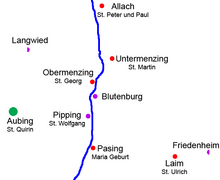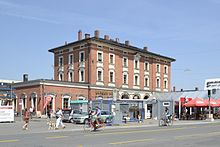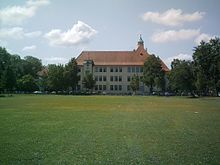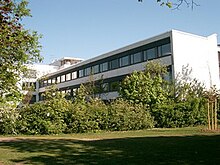Pasing
Pasing is a district of Munich , which since the reorganization of the districts together with Obermenzing forms the district 21 Pasing-Obermenzing .
City until 1938
Pasing, which was an independent city until 1938, which was compulsorily incorporated into Munich , was a center of what was then the Munich district . To this day, Pasing is characterized by its own self-confidence and an infrastructure that is almost independent of Munich.
location
Pasing is located in the west of the state capital on both sides of the Munich-Pasing railway to Munich Hbf. In the east it borders on Laim along Willibaldstrasse . To the south, fields and meadows separate the Blumenau and Lochham . To the west it is separated from the Munich – Garmisch-Partenkirchen and Munich – Augsburg lines from Lochham and Aubing . To the north, the district finally borders on Obermenzing .
history
The history of the district of Munich Pasing can be divided into the following sections.
Beginnings until 1803

Pasing was first mentioned on June 29, 763 as villa Pasingas . The name is derived from the proper name of a Poaso / Poso or Paoso / Paso. Excavations suggest an uninterrupted settlement continuity from the Bronze Age on.
In 1158, Heinrich the Lion forcibly relocated the Salt Road away from Oberföhring to the south. This made the Würm crossing at Pasing more important. Two important road connections crossed at Pasing: Munich-Swabia in east-west direction and Dachau-Starnberg in north-south direction.
There is only sparse news and testimonies about Pasing in the Middle Ages. Several monasteries, u. a. the monastery Scharnitz-Schlehdorf that Schäftlarn and the monastery Benediktbeuern could acquire land in Pasing. However, the Bishop of Freising had a decisive influence. The feudal affinity of the bishopric of Freising remained until the secularization in 1803, the ministerials until then had their seat on the so-called moated castle , a castle-like fortification surrounded by the Würm , which remained the lordly center until 1803. But the Bavarian electoral house also succeeded in gaining fiefdom over a smaller bailiwick , a mill and a tavern in order to gain significant points in Pasing. In the case file of Andre Reitmor before the Imperial Court of Justice in 1557, the first pictorial representation of Pasing appears; it shows a central location on the trade route from Landsberg am Lech to Munich. Since the 16th century, Pasing has been mentioned in the documents or kept in the files as Hofmark with its own lower jurisdiction. Fiefdoms of the Hofmark Pasing were not only noble ducal-electoral officials, for example from the Schwarzenberg, Neuburger and Berchem families, but also Munich patricians , so that a close relationship with Munich soon developed.
1803 to 1918
The over-indebted Berchem family sold the Hofmark property to King Max I Joseph's civil list in 1814 ; thus the moated castle became the property of the Wittelsbach family . After it had passed to Prince Carl in 1817, it was demolished and a small country palace was built on the southern outskirts , which was expanded in 1869 to become today 's Gatterburg Palace . With the new regional court division in 1802, with which Pasing was assigned to the Munich regional court, the forerunner of today's Munich district, and the elevation to an independent municipality with its own patrimonial court in 1818, the old political order as Hofmark was overcome. The patrimonial jurisdiction, including the Hofmark property and the small castle, went to knight Felix von Hilz in 1834 and to Baron Karl von Beck in 1840. Both belonged to the newly aristocratic property bourgeoisie, for whom their Pasingen property was primarily an object of speculation. This is how the first industrial companies came into being, of which Beck’s machine-paper factory , which opened in 1842/43, was the largest for a long time. In addition to the considerable industrial companies in the Munich region, Pasing also remained dominated by agriculture.
The opening of the second Bavarian railway line Munich – Augsburg in 1840 had a lasting impact on Pasing's development. A station building was built as early as 1854 to replace a wooden shack as a breakpoint. At the same time, Pasing developed through the integration of the rail connections and a. from Gauting (since July 16, 1854), Starnberg (since November 28, 1854), Buchloe (since 1874) and Herrsching (since 1903) towards Munich Central Station to the star in the railway network around Munich. Trade, trade and industry were largely driven away to Pasing by Munich's restrictive economic policy. The spectrum ranged from the Joachim Fromm hop shop, the Fritz Berne wood dealers and the Freundlich brothers, to shoe factories and filament production. The Regensteiner shoe factory was established in 1891, and the Heymann shoe factory (now the Pasinger factory ) five years later . The influx was enormous, the housing situation for the workers was often pathetic. A Pasing labor movement and cooperative housing developed. At the same time, typical “garden cities” emerged as a result of the reform movement and were gratefully accepted by the Munich bourgeoisie and artists. As early as July 16, 1891, the Pasing Volunteer Medical Column was founded (today the second oldest standby in Munich). The Munich district, today's district of Munich, promoted more and more institutions, especially schools. The railway body sealed off the actual Pasing to the north and thus ensured the exclusivity of the villa colonies that arose in the vicinity of Obermenzing. At the same time, Pasing became popular as a destination for excursions and as a starting point for pilgrimages and walks in the direction of Maria Eich .
Pasing became wealthy and began to develop into a city in the sense of the 19th century. Farmhouses gave way to the new buildings of an independent post office, a fire station and schools. In 1901 Emil Neuburger opened the "Pasinger Kaufhaus" opposite the train station. The traffic infrastructure improved considerably through paving. However, Pasing was in debt to a not inconsiderable extent.
The district municipality of Munich on the left of the Isar, a predecessor of today's Munich district, chose Pasing as its center for the western district. So in 1884 the asylum and hospital of the district on the left of the Isar , the later district hospital Pasing, today Klinikum München Pasing was created .
Since 1903 the groups that demanded that Pasing be elevated to town were in the majority. The reason was probably the fear of incorporation into the royal capital and residence city of Munich. These were still nourished after the neighboring communities in Pasing Nymphenburg in 1899 and Laim in 1900 were incorporated into Munich. So the city elevation of Pasing was pushed. After a corresponding resolution of the community committee of May 18, 1904 had been accepted by the assembly of all community citizens entitled to vote on June 22, 1904, the Royal Ministry of the Interior elevated Pasing to the city of January 1, 1905 in a resolution of November 8, 1904. Other new buildings such as the Progymnasium (now the Karlsgymnasium ) built in 1909/10 or the Catholic parish church Maria Schutz, built by Hans Schurr from 1906 to 1918, were symbols of the new urban pride, as was the city coat of arms awarded in 1908.
Pasing was also the seat of the Royal School of Applied Arts in Munich , which was founded in 1868 and incorporated into the Munich Art Academy in 1946 . The Art Nouveau artist, architect and professor Richard Riemerschmid was the director of the Kunstgewerbeschule from 1913 to 1924 . In 1910 Pasing received a teacher training institute (today part of the Munich University of Applied Sciences ).
1919 to 1945
This time was characterized by the struggle for independence, began after the end of the First World War and lasted until the forced incorporation in 1938. The First World War ended the upward trend in Pasing. Projects such as a municipal sewer system or a town hall could not be pursued. A year earlier than Munich, the City of Pasing's Economic Office was able to regulate the food supply. The introduction of a Pasinger emergency money in 1918 also led to a certain economic calm. On April 7, 1919, a “ revolutionary workers' council ” took power, but it resigned twelve days later - without bloodshed - and apologized for the “hasty dismissal” of the municipal authorities.
In the 1920s, under Mayor Alois Stephan Wunder , who had been at the head of the city since 1914, investments in infrastructure and the cityscape were promoted, city and gas works were founded and the school infrastructure was further expanded. 1925, efforts were made freely of circle to be. This was seen as a better protection against the impending incorporation into the state capital Munich. However, corresponding applications were rejected. However, the 1st mayor was allowed to use the title "Lord Mayor".
After the National Socialists came to power in 1933, it became more and more difficult to maintain Pasing's independence. The expansion of Munich into the “ capital of the movement ” made incorporation on a larger scale inevitable, because the Nazis wanted to make Munich one of the largest cities in the empire in terms of area and population. Through skillful conduct of negotiations, Wunder, NSDAP member since May 1, 1937, managed to delay the incorporation by one year and the contractually guaranteed "people and local administration". As a result, Pasing succeeded as the only incorporation to get its own district administration, which was directly subordinate to the Mayor of Munich. With a contract dated January 8, 1938, Pasing was separated from the Munich district office with effect from April 1, 1938 and incorporated into Munich.
After 1945
1949 tried a citizens' initiative, by Pasing On the My Dung released again from the bond with Munich and to raise the independent city. This attempt failed, however, because the city of Munich could not prove a breach of contract, but loyalty to the contract. On March 31, 2005, the provisions of the incorporation agreement of January 8, 1938 were dissolved by the city council at the request of Munich's Lord Mayor Christian Ude , and thus the complete incorporation of Pasing into Munich, which had already been aimed for during the National Socialist era, was completed.
In 1967 Helmut Winter (1919–2013) shot potato dumplings at Starfighter of the Luftwaffe together with fellow soldiers in Pasing . This action, referred to by the media as the dumpling war (“big dumpling war”), received national and, in some cases, international reports. So Helmut Winter achieved a change in the flight corridors used by the Air Force.
Coat of arms of the former city of Pasing
After Pasing was promoted to town in 1905, the Royal Ministry of the Interior awarded its own town coat of arms on July 20, 1908, which had been designed by Otto Hupp .
Description: A silver tin tower in red on a green island flooded by a silver river.
The coat of arms is based on elements of the family coat of arms of the former court rulership of Berchem.
Since the incorporation into the city of Munich in 1938 , the city council of the state capital Munich has all rights to use and manage the coat of arms. It can still be found frequently in Pasing and is used by many traditional clubs.
politics
The district committee of Pasing-Obermenzing was last elected on March 15, 2020.
The distribution of seats is as follows:
GREEN: 11
CSU: 10
SPD: 6
ÖDP / FW: 2
FDP: 1
AFD: 1
The Greens provide the district committee chair. The turnout was 54.0 percent.
population
On December 31, 1991, Pasing had 39,723 inhabitants and extended over an area of 1,074 hectares, on December 31, 2017, 43,441 inhabitants. There has been no separate information about the size of Pasing since 1991, since it has since been recorded together with Obermenzing .
The social, age and household structure has no abnormalities. All strata of the population are at home in Pasing and none are dominant, which is due to the independent urban development.
economy
Pasing is characterized by a balanced economic structure. The distribution of the 21,000 jobs across manufacturing, trade, transport and the other economic sectors is even. There is no focus on a commercial area. In addition to the diverse offerings in the town center, there is the Pasing Arcaden shopping center .
traffic

In terms of private transport , Pasing is mainly characterized by the Bodenseestraße / Landsberger Straße axis, which as a west-east axis is part of the old trade route from Landsberg am Lech to Munich and is now part of the B 2 , as well as by Planegger Straße, which is called North South axis opens up the district. A little west of the center, the Pasinger Marienplatz , Maria-Eich-Straße connects Pasing with Lochham and, in its extension north of Bodenseestraße, Lortzingstraße connects Pasing with Obermenzing .
To relieve the center of Pasing and its pedestrian-friendly design, the B2 was swiveled and routed via the northern bypass (NUP). This new bypass, the construction of which began in 2008, was opened to traffic in 2012.
In public transport in Pasing is the train station Munich-Pasing as a train station with ICE system maintenance, as well as a western beginning of the S-Bahn route of importance. At the same time, the Munich – Pasinger Marienplatz tram , which opened in 1908 and is now served by tram line 19, is important. In 2014 the tram route was extended by around 800 meters, since then the tram has been running directly to Pasinger Bahnhofsplatz, and numerous bus routes also serve it. The extension of the U5 to the Munich-Pasing station had been firmly planned since the beginning of the underground era, and several city council resolutions, most recently in 2005, confirmed the decision to implement this route. The start of construction was postponed again and again due to doubts about the economic efficiency and the traffic benefits. On July 14, 2015, the city council decided to build the U5 to Pasing with a large majority. According to current plans, the construction of the route should begin in 2019. Due to the discussion about the public transport connection of the new Freiham district , which is to be accessed by tram - or even subway - via Pasing, the topic was kept public.
Public facilities
- Cultural center Pasinger Fabrik
- Civic center Rathaus Pasing in the Pasing town hall
- Klinikum München Pasing of HELIOS Kliniken GmbH (formerly Kreiskrankenhaus München-Pasing)
- Alfons Hoffmann retirement home
- Westbad with summer pool at Weinbergerstraße 11.
Schools and educational institutions
Pasing is often referred to as a school town or school district, as there is an above-average number of educational institutions - especially high schools and higher education institutions:
- Kermess schools
- Samuel Heinicke Schools of the SchulCentrum Augustinum in Dachstraße ,
with Samuel Heinicke Realschule , technical college and Protestant college - Elementary school on Bäckerstraße
- Primary school on Oselstrasse
- Elementary school at Schererplatz
- Special Education Center Munich-West, Schererplatz 3
- Primary and secondary school on Peslmüllerstrasse, since September 2011: Middle school on Peslmüllerstrasse
- bilingual Jan Amos Comenius primary school of the Munich School Foundation -Ernst v. Borries
- Anne Frank Realschule
- Karlsgymnasium Munich-Pasing
- Max Planck High School
- Elsa-Brändström-Gymnasium
- Municipal Bertolt-Brecht-Gymnasium
- State Business School Munich
- Munich Adult Education Center , City Center West, Bäckerstraße 14
- Faculties of the Munich University of Applied Sciences: business administration, social affairs and tourism
- State Institute for the Training of Specialized Teachers Division II
- Evangelical Friedrich-Oberlin technical college
Attractions

- Old Pasing train station by Friedrich Bürklein, Entrance building of the Pasing train station
- Pasinger Mariensäule , Pasinger Marienplatz
- Cellar vault of the former Pasing Castle on the island in the institute garden
- Bismarck fountain, Wensauer Platz
- Gatterburg Castle
- Pasing mosque
Architectural monuments
Green spaces
- Würm , Würm green corridor with Pasinger Stadtpark
- Würm canal system from Pasing to Nymphenburg Palace Park , Pasing-Nymphenburg Canal
- Pasing city park
- Park am Durchblick at Blutenburg Castle
- Munich green belt
Important events and weekly markets
Personalities
Sons and daughters
- Maximilian Thomas von Aicher (1753–1831), Royal Bavarian Major General
- Lina Meittinger (1856–1928), actress and soubrette
- Fritz Steinmetz-Noris (1860–1923), painter
- Heinrich FS Bachmair , pseudonym Jacobus Fellgiebel (1889–1960), publisher, poet and narrator
- Heinrich Müller (1896–1945), lawyer, administrative officer and politician (NSDAP)
- Georg Lorenz (1897–1958), journalist
- Carl Müller (1903–1990), Swiss gynecologist
- Hans Osel (1907–1996), sculptor
- Ernst von Khuon (1915–1997), radio and television journalist and author of non-fiction books and novels
- Gisela von Poellnitz (1911–1939), journalist and resistance fighter
- Wolfram Hausmann (1922–2006), geographer and hammer thrower
- Dieter Albrecht (1927–1999), historian
- Wolfgang Lauter (* 1946), graphic designer, photographer and artist
- Udo Wachtveitl (* 1958), actor and director
- Albert Eckert (* 1960), civil rights activist and politician
- Shandra Schadt (* 1982), voice actress and actress
- Felix Neureuther (* 1984), ski racer
- Tobias Strobl (* 1990), soccer player
Connected People
- Alois Brummer (1926–1984), sex film producer and director, lived, worked and died in Pasing
- Michael Ende (1929–1995), writer, spent his childhood and youth in Pasing
- August Exter (1858–1933), architect, designed the Kolonie I residential estate in Pasing in 1892
- Fritz Fenzl (* 1952), writer
- Gerhard Frey (1933–2013), right-wing extremist publisher and federal chairman of the DVU , lived in Pasing
- Robert Huber (* 1937), Nobel Laureate in Chemistry (1988), laid in 1956 graduated from high school at Karlsgymnasium from
- Ellis Kaut (1920–2015), writer, creator of Pumuckl
- Harry Marcus (1880–1976), anatomist and entomologist, lived in Pasing until 1938 and from 1954, persecuted by the Nazi regime
- Rudolf Mossbauer (1929-2011), Nobel Laureate in Physics (1961), laid in 1948 graduated from high school at the secondary school Pasing from
- Emil Neuburger (1870–1938), businessman and councilor in Pasing (SPD), persecuted by the Nazi regime.
- Hans Nimmerfall (1872–1934), Pasinger city councilor and Bavarian. Member of the state parliament (SPD), founder of the Pasinger building cooperative Sporer-Block , victim of the Nazi regime
- Otto Numberger , architect, shaped Colony II and created the fire house and the old Pasinger town hall (Bäckerstr. 14)
- Georg Schuster (1921–2011), parish priest of Pasing 1968–2001, significantly involved in the rebuilding of the Pasing Marian Column (1980)
- Franz Stenzer (1900–1933) Member of the Reichstag (KPD) 1932, victim of the Nazi regime
- Berthold Sterneck (1887–1943), opera singer, lived in Pasing, a victim of the Nazi regime
- Walther von La Roche (1936–2010), journalist, lived in Pasing
- Alois Wunder (1878–1974), sole mayor of the former town of Pasing
See also
Individual evidence
- ^ Judith Ammon, Almuth David: Kulturlandschaft Würm: from Pasing to Allach, building department of the state capital Munich
- ↑ a b see railway line Munich – Garmisch-Partenkirchen # construction to Starnberg
- ^ Wilhelm Volkert (ed.): Handbook of Bavarian offices, communities and courts 1799–1980 . CH Beck, Munich 1983, ISBN 3-406-09669-7 , p. 601 .
- ↑ Pasinger Knödelschütze Helmut Winter died at the age of 93
- ↑ Announcement of the final result of the election of District Committee 21 in the City of Munich (PDF). State capital Munich. Retrieved April 25, 2020
- ↑ Open Data Portal Statistical Office Munich. Retrieved May 2, 2018
- ↑ Planned U5 extension to Pasing takes the next hurdle
- ↑ Kermess - business school, vocational school, hotel management school, adult education and wine academy further education in Munich Pasing. Retrieved June 5, 2018 .
- ^ Biography in the Munzinger archive
literature
- Richard Bauer , Gerhard Bauer: Pasing - city in front of the city. The development from 1800 to 1938 . Buchendorfer Verlag, Buchendorf 1996, ISBN 3-927984-58-2 .
- Helmuth Stahleder : From Allach to Zamilapark. Names and basic historical data on the history of Munich and its incorporated suburbs. Edited by Munich City Archives . Buchendorfer Verlag, Munich 2001, ISBN 3-934036-46-5 .
- Gudrun Azar u. a .: Moved into the light. Jewish life in the west of Munich. Edited for the history workshop of Jewish life in Pasing by B. Schoßig . Herbert Utz Verlag, Munich 2008, ISBN 978-3-8316-0787-7 .
- Pasinger Fabrik GmbH (Ed.): Architect August Exter - Villas Colonien Pasing; Publication for the exhibition October 2 - 31, 1993; Buchendorfer Verlag, Munich 1993; ISBN 3-927984-19-1
Web links
- City of Munich :
- Adolf Thurner: Pasing. A historical review.
- Pasinger Archive e. V.
- Culture and History Paths> District 21: Pasing-Obermenzing - City of Munich
Coordinates: 48 ° 9 ′ 0 ″ N , 11 ° 27 ′ 0 ″ E







